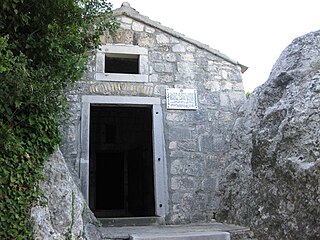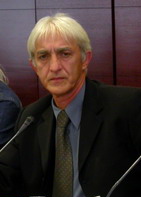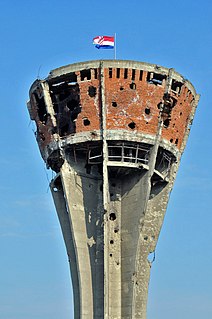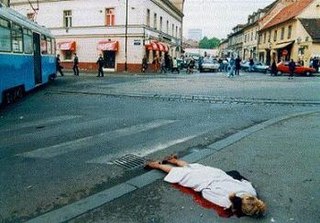 W
WŽeljko Ražnatović, better known as Arkan, was a Slovenian-born Serbian paramilitary commander and head of the Serb paramilitary force called the Serb Volunteer Guard during the Yugoslav Wars. He was on Interpol's most wanted list in the 1970s and 1980s for robberies and murders committed in a number of countries across Europe, and was later indicted by the International Criminal Tribunal for the former Yugoslavia for crimes against humanity. Ražnatović was, up until his death, the most powerful organized crime figure in the Balkans. He was assassinated in January 2000.
 W
WThe Baćin massacre was the killing of 83 civilians just outside the village of Baćin, near Hrvatska Dubica, committed by Croatian Serb paramilitaries. The killings took place on 21 October 1991 during the Croatian War of Independence. Most of the civilians were Croats, but they also included two ethnic Serbs, taken from Hrvatska Dubica, Baćin and the nearby village of Cerovljani. The civilians were killed in the area of Krečane, at the very bank of the Una River, and their bodies were left unburied for two weeks. Most of them were subsequently bulldozed into a shallow mass grave, while a number of the bodies were thrown into the river.
 W
WThe Begejci camp was a detention camp established in September–October 1991 in Begejci near Zrenjanin, Serbia where Croatian prisoners of war and civilians were kept by Serbian authorities during the Croatian War of Independence. The detainees were mostly brought from Vukovar and some were later moved to other camps. At east three people are known to have died there. The camp was opened in the autumn of 1991, and held approximately 600 prisoners. The ICTY cited 260 detainees in its indictment against Slobodan Milošević.
 W
WThe Bruška massacre took place on 21 December 1991 in Bruška, a small village near the Croatian town of Benkovac when Serbian paramilitaries executed 10 civilians in the hamlet of Marinovići. Nine were members of the Marinović family and one was a Serb neighbor. They were led out of the house after playing cards and shot on the spot by members of a paramilitary group called "Knindže".
 W
WThe Bučje camp was an internment camp run by rebel Croatian Serb forces during the early stages of the Croatian War of Independence. Located in the village of Bučje near Pakrac, the camp was used for the imprisonment of 200–300 Croatian civilians, prisoners of war, other non-Serbs, as well as Serbs that sided with the Croatian government or refused to join Serbian paramilitary groups. The camp was the site of numerous war crimes including murder, rape and torture. Twenty-two detainees are still listed as missing as of December 2013.
 W
WThe Dalj massacre was the killing of 56 or 57 Croats in Dalj, Croatia on 1 August 1991, during the Croatian War of Independence. In addition to civilian victims, the figure includes 20 Croatian policemen, 15 Croatian National Guard troops and four civil defencemen who had been defending the police station and water supply building in the village. While some of the policemen and the ZNG troops died in combat, those who surrendered were killed after they became prisoners of war. They tried to fight off an attack by the Croatian Serb SAO Eastern Slavonia, Baranja and Western Syrmia Territorial Defence Forces, supported by the Yugoslav People's Army and the Serb Volunteer Guard paramilitaries. The SAO SBWS was declared an autonomous territory in eastern Croatia following the Battle of Borovo Selo just to the south of Dalj.
 W
WThe Siege of Dubrovnik was a military engagement fought between the Yugoslav People's Army (JNA) and Croatian forces defending the city of Dubrovnik and its surroundings during the Croatian War of Independence. The JNA started its advance on 1 October 1991, and by late October, it had captured virtually all the land between the Pelješac and Prevlaka peninsulas on the coast of the Adriatic Sea, with the exception of Dubrovnik itself. The siege was accompanied by a Yugoslav Navy blockade. The JNA's bombardment of Dubrovnik, including that of the Old Town—a UNESCO World Heritage Site—culminated on 6 December 1991. The bombardment provoked international condemnation, and became a public relations disaster for Serbia and Montenegro, contributing to their diplomatic and economic isolation, as well as the international recognition of Croatia's independence. In May 1992, the JNA retreated to Bosnia and Herzegovina, less than 1 kilometre from the coast in some places, and handed over its equipment to the newly formed Army of Republika Srpska (VRS). During this time, the Croatian Army (HV) attacked from the west and pushed back the JNA/VRS from the areas east of Dubrovnik, both in Croatia and in Bosnia and Herzegovina, and by the end of May linked up with the HV unit defending the city. Fighting between the HV and Yugoslav troops east of Dubrovnik gradually died down.
 W
WThe Erdut killings were a series of murders of 37 Hungarian and Croat civilians in the village of Erdut, Croatia committed by Croatian Serb forces and Serb Volunteer Guard paramilitaries between November 1991 and June 1992, during the Croatian War of Independence. Twenty-two Hungarians and 15 Croats were killed. The first killings occurred on 10 November 1991, when twelve civilians died. Eight more were killed over the following several days. Five more civilians were killed on 10 December, and another seven on 16 December. Four others were killed on 21 February 1992 and the final one was killed on 3 June. The bodies of these victims were either buried in mass graves or thrown into nearby wells.
 W
WThe Gornje Jame massacre was the killing of fifteen Croat civilians in Gornje Jame, a village near Glina, by the Serbian paramilitary force called Šiltovi.
 W
WJoint criminal enterprise (JCE) is a legal doctrine used during war crimes tribunals to allow the prosecution of members of a group for the actions of the group. This doctrine considers each member of an organized group individually responsible for crimes committed by group within the common plan or purpose. It arose through the application of the idea of common purpose and has been applied by the International Criminal Tribunal for the former Yugoslavia to prosecute political and military leaders for mass war crimes, including genocide, committed during the Yugoslav Wars 1991–1999.
 W
WThe Joševica massacre was a war crime committed by the paramilitary forces of the Krajina Serbs in the Croatian village of Joševica during the Croatian War of Independence. The atrocities took place on December 16 of 1991.
 W
WThe 1991 siege of Kijevo was one of the earliest conflicts in the Croatian War of Independence. The 9th Corps of the Yugoslav People's Army led by Colonel Ratko Mladić and the forces of the Serbian Autonomous Oblast (region) of Krajina under Knin police chief Milan Martić besieged the Croat-inhabited village of Kijevo in late April and early May 1991. The initial siege was lifted after negotiations that followed major protests in Split against the JNA.
 W
WKnin camp was a detention camp run by the rebel Serb army in Knin in the puppet state of Republika Srpska Krajina, that held Croatian detainees, soldiers and civilians, from 1991 until 1992, during the Croatian War of Independence. It consisted out of at least two facilities. The ICTY stated that a prison in Knin, run by the Yugoslav People's Army, held approximately 150 detainees, while the old hospital in Knin, run by "Martic's Militia", held approximately 120 detainees. At least two prisoners perished.
 W
WThe Kostrići massacre was the killing 16 Croat civilians in the village of Kostrići, near Hrvatska Kostajnica by Serb paramilitary unit "Kaline Komogovina" on 15 November 1991 during the Croatian War of Independence. Among those killed were two children. The oldest victim was 93 years old.
 W
WOperation Labrador was a false flag operation carried out by the Yugoslav Air Force's Counterintelligence Service (KOS) in the Croatian capital city of Zagreb during the early stages of the Croatian War of Independence. It was devised as a series of terrorist attacks intended to create an image of Croatia as a pro-fascist state. Two bombings were carried out on 19 August 1991, with one at the Jewish Community Centre and a second near Jewish graves at the Mirogoj Cemetery; there were no casualties. Additional attacks targeted the national railway network and were designed to implicate the Croatian President. Operation Labrador was complemented by Operation Opera — a propaganda campaign devised by the KOS to feed disinformation to the media.
 W
WThe Lovas killings involved the killing of 70 Croat civilian residents of the village of Lovas between 10–18 October 1991, during the Croatian War of Independence. The killings took place during and in the immediate aftermath of the occupation of the village by the Yugoslav People's Army supported by Croatian Serb forces and Dušan Silni paramilitaries on 10 October, two days after Croatia declared independence from Yugoslavia. The occupation occurred during the Battle of Vukovar, as the JNA sought to consolidate its control over the area surrounding the city of Vukovar. The killings and abuse of the civilian population continued until 18 October, when troops guarding a group of civilians forced them to walk into a minefield at gunpoint and then opened fire upon them.
 W
WThe Novo Selo Glinsko massacre was the mass murder of Croat civilians in two separate massacres committed by Serb forces on 3 and 16 October 1991.
 W
WThe Poljanak and Vukovići massacres was the mass murder of Croat civilians in the villages of Poljanak and Vukovići committed by SAO Krajina forces, supported by the JNA and TO forces on 7 November 1991.
 W
WThe Saborsko massacre was the killing of 29 Croat residents of the village of Saborsko on 12 November 1991, following the seizure of the village in a Yugoslav People's Army and Croatian Serb offensive during the Croatian War of Independence. The fall of the town occurred as part of a JNA and Croatian Serb operation to capture a Croatian-held pocket centered on the town of Slunj, southeast of Karlovac. While the bulk of the civilian population fled with the surviving Croatian forces, those who remained in Saborsko were rounded up and either killed or expelled. The bodies of the victims were retrieved from two mass graves and several individual graves in 1995.
 W
WThe Serb Volunteer Guard, also known as Arkan's Tigers or Arkan's men, was a Serbian volunteer paramilitary unit founded and led by Arkan that fought in Croatia (1991–93) and Bosnia (1992–95) during the Yugoslav Wars.
 W
WThe Široka Kula massacre was the killing of 41 civilians in the village of Široka Kula near Gospić, Croatia during the Croatian War of Independence. The killings began on 13 October 1991 and continued until late October. They were perpetrated by the Croatian Serb SAO Krajina police and generally targeted ethnic Croat civilians in Široka Kula. Several victims were ethnic Serbs suspected by the police of collaboration with Croatian authorities. Most of the victims' bodies were thrown into the Golubnjača Pit, a nearby karst cave.
 W
WThe Škabrnja massacre was the killing of 62 Croatian civilians and five prisoners of war by Serbian Autonomous Oblast Krajina Territorial Defence troops and the Yugoslav People's Army (JNA) in the villages of Škabrnja and Nadin northeast of Zadar on 18–19 November 1991, during the Croatian War of Independence. The massacre occurred shortly after an agreement to evacuate Zadar's JNA garrison following an increase in fighting between the Croatian National Guard and the JNA.
 W
WThe Stajićevo camp was an agricultural farm in Stajićevo near Zrenjanin, Serbia where Croatian prisoners of war and civilians were kept by Serbian authorities. The camp also acted as a transit facility where prisoners were taken before being moved to the Sremska Mitrovica camp. Individual reports have said that 1500 people were held there. The ICTY's figure for the camp was 1700 detainees.
 W
WThe Tovarnik massacre was the mass murder of Croat civilians by Serb forces on 22 September 1991 in the village of Tovarnik.
 W
WDragan Vasiljković, nicknamed Captain Dragan, was the commander of a Croatian Serb paramilitary unit called the Knindže during the Yugoslav Wars. In 2005, prosecutors in Croatia accused him of committing war crimes during the wars. A warrant for his arrest was subsequently issued by Interpol. He was arrested in Australia in January 2006, and ordered to prison by the High Court of Australia in anticipation for extradition to Croatia to face prosecution for his alleged crimes. He was extradited to Croatia on 8 July 2015 after losing his thirteenth appeal and sentenced to 15 years in prison on 26 September 2017 by the County Court in the city of Split. He was released from prison in March 2020.
 W
WThe Velepromet camp was a detention facility established in the final days of the Battle of Vukovar during the Croatian War of Independence. The camp was set up by the Yugoslav People's Army (JNA), which shared control of the facility with Croatian Serb rebels. The facility, originally an industrial storage site, was located on the southern outskirts of the city of Vukovar, in close proximity to the JNA barracks. It consisted of eight warehouses surrounded by a wire fence, and was established on 16 November 1991, when the first detainees were brought there.
 W
WThe Voćin massacre was the killing of 43 civilians in Voćin, Croatia, by the Serbian White Eagles paramilitary unit on 13 December 1991, during the Croatian War of Independence. The massacre was carried out after the unit was ordered to abandon the village before the Croatian Army recaptured the area in Operation Papuk-91. All the victims were local Croats, save one Serb, who had tried to protect his neighbours. Gunfire was the leading cause of death, though some of the victims were killed with axes or chainsaws, or were burned to death. The victims exhibited signs of torture and were left unburied. On the night of 13–14 December, the White Eagles dynamited a 550-year-old church in the village.
 W
WThe Vukovar massacre, also known as the Vukovar hospital massacre or the Ovčara massacre, was the killing of Croatian prisoners of war and civilians by Serb paramilitaries, to whom they had been turned over by the Yugoslav People's Army (JNA), at the Ovčara farm southeast of Vukovar on 20 November 1991, during the Croatian War of Independence. The massacre occurred shortly after Vukovar's capture by the JNA, Territorial Defence (TO), and paramilitaries from neighbouring Serbia. It was the largest massacre of the Croatian War of Independence.
 W
WThe Battle of Vukovar was an 87-day siege of Vukovar in eastern Croatia by the Yugoslav People's Army (JNA), supported by various paramilitary forces from Serbia, between August and November 1991. Before the Croatian War of Independence the Baroque town was a prosperous, mixed community of Croats, Serbs and other ethnic groups. As Yugoslavia began to break up, Serbia's President Slobodan Milošević and Croatia's President Franjo Tuđman began pursuing nationalist politics. In 1990, an armed insurrection was started by Croatian Serb militias, supported by the Serbian government and paramilitary groups, who seized control of Serb-populated areas of Croatia. The JNA began to intervene in favour of the rebellion, and conflict broke out in the eastern Croatian region of Slavonia in May 1991. In August, the JNA launched a full-scale attack against Croatian-held territory in eastern Slavonia, including Vukovar.
 W
WThe Zagreb rocket attacks were a series of two rocket attacks conducted by the Army of the Republic of Serbian Krajina that used multiple rocket launchers to strike the Croatian capital of Zagreb during the Croatian War of Independence. The attack killed seven and wounded over 200 Croatian civilians and was carried out on 2 May and 3 May 1995 as retaliation for the Croatian army's offensive in Operation Flash. The rocket attacks deliberately targeted civilian locations. Zagreb was the largest of several cities hit by the attack. It was the only instance in the entire war in Croatia that cluster bombs were used in combat.